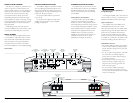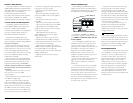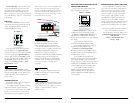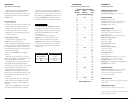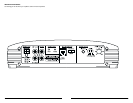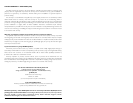
JL AUDIO e1800D 13
“MY AMPLIFIER TURNS ON, BUT THERE IS NO OUTPUT”
Check the input signal using an AC voltmeter to measure the voltage
from the source unit while an appropriate test tone is played
through the source unit (disconnect the input cables from the
amplifier prior to this test).The frequency used should be in
the range that is to be amplified by the amplifier
(example: 50 Hz for a sub bass application or 1 kHz for a full
range / high-pass application). A steady, sufficient voltage
(between 0.2 and 8.0V) should be present at the output of
the signal cables.
Check the output of the amplifier. Using the procedure explained in
the previous check item (after plugging the input cables back
into the amplifier) test for output at the speaker outputs of the
amplifier. Unless you enjoy test tones at high levels, it is a good
idea to remove the speaker wires from the amplifier while
doing this. Turn the volume up approximately half way.
5V or more should be measured at the speaker outputs. This
output level can vary greatly between amplifiers but it should
not be in the millivolt range with the source unit at half
volume. If you are reading sufficient voltage, check your speaker
connections as explained below.
Check to ensure that the speaker wires are making a good
connection with the metal inside the terminal block. The
speaker wire connectors are designed to accept up to
12 AWG wire. Make sure that 1/2 inch (12 mm) of insulation
has been stripped from the end of each wire and the bare
wire is seated firmly in the terminal block so that no bare
wire is exposed.
“MY AMPLIFIER’S OUTPUT FLUCTUATES WHEN I TAP ON IT OR HIT A BUMP”
Check the connections to the amplifier. Make sure that the insulation
for all wires has been stripped back far enough to allow a
good contact area inside the terminal block.
Check the input connectors to ensure that they all are making good
contact with the input jacks on the amplifier.
“HOW DO I PROPERLY SET THE INPUT SENSITIVITY ON MY AMPLIFIER”
Please refer to Appendix A (page 10) to set the input sensitivity for
maximum, low-distortion output.
“MY AMPLIFIER DOESN’T TURN ON”
Check to make sure there is +12V at the “Remote” connection of
the amplifier. In some cases, the turn-on lead from the source
unit is insufficient to turn on multiple devices and the use of a
relay is required. To test for this problem, jump the “+12V”
wire to the “Remote” terminal to see if the amplifier turns on.
If this does not work, proceed to the next step.
Check the fuse, not just visually, but with a continuity meter. It is
possible for a fuse to have poor internal connections that
cannot be found by visual inspection. It is best to take the fuse
out of the holder for testing. If no problem is found with the
fuse, inspect the fuse-holder.
“I GET A DISTORTED / ATTENUATED SOUND COMING OUT OF THE SPEAKER(S)”
Check the input signal and input signal cables to make sure signal is
present at the “Amplifier Inputs” and the cables are not
pinched or loose. It may be helpful to try a different set of
cables and/or a different signal source to be sure.
“MY AMPLIFIER SHUTS OFF ONCE IN A WHILE, USUALLY AT HIGHER VOLUMES”
Check your voltage source and grounding point.The power supply of
the e1200 will operate with charging system voltages down to
8V. Shutdown problems at higher volume levels can occur
when the charging system voltage drops below 8V.These dips
can be of very short duration making them extremely difficult
to detect with a common DC voltmeter.To ensure proper
voltage, inspect all wiring and termination points. It may also be
necessary to upgrade the ground wire connecting the battery
to the vehicle’s chassis and the power wire connecting the
alternator to the battery. Many vehicles employ small
(10 AWG - 6 AWG) wire to ground the battery to the vehicle’s
chassis and to connect the alternator to the battery.To prevent
voltage drops, these wires should be upgraded to 4 AWG
when installing amplifier systems with main fuse ratings above
60A. Grounding problems are the leading cause of
mis-diagnosed amplifier failures.
12 JL AUDIO e1800D
APPENDIX D: TROUBLE SHOOTING




